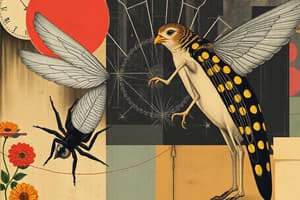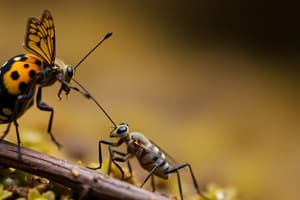Podcast
Questions and Answers
Which of the following examples illustrates mutualism?
Which of the following examples illustrates mutualism?
- Clownfish and sea anemone (correct)
- Mistletoe growing on a tree
- Head lice on humans
- Carmine Bee Eaters and their habitat
In commensalism, one species benefits while the other is harmed.
In commensalism, one species benefits while the other is harmed.
False (B)
What term describes the interaction in which one species benefits at the expense of another?
What term describes the interaction in which one species benefits at the expense of another?
Parasitism
In predation, one species benefits and the other species _____?
In predation, one species benefits and the other species _____?
Match the following interactions with their descriptions:
Match the following interactions with their descriptions:
What defines mutualism in symbiosis?
What defines mutualism in symbiosis?
In parasitism, one species benefits while the other is left unaffected.
In parasitism, one species benefits while the other is left unaffected.
What is an example of a relationship where one species benefits and the other is harmed?
What is an example of a relationship where one species benefits and the other is harmed?
In predation, one species benefits while the other species _____?
In predation, one species benefits while the other species _____?
Match the following interactions with their descriptions:
Match the following interactions with their descriptions:
Flashcards
Symbiosis
Symbiosis
Interactions between two different species living together.
Mutualism
Mutualism
A symbiotic relationship where both species benefit from the interaction.
Commensalism
Commensalism
A symbiotic relationship where one species benefits and the other is neither harmed nor helped.
Parasitism
Parasitism
Signup and view all the flashcards
Predation
Predation
Signup and view all the flashcards
Competition
Competition
Signup and view all the flashcards
Clownfish and Anemone
Clownfish and Anemone
Signup and view all the flashcards
Carmine Bee Eaters
Carmine Bee Eaters
Signup and view all the flashcards
Head Lice and Humans
Head Lice and Humans
Signup and view all the flashcards
Mistletoe and Trees
Mistletoe and Trees
Signup and view all the flashcards
Study Notes
Symbiosis Overview
- Symbiosis refers to interactions between two different species.
- There are five main types of symbiotic relationships: mutualism, commensalism, parasitism, predation, and competition.
Mutualism
- Both species benefit from the relationship.
- Example: Clownfish find protection within an anemone while attracting food for the anemone through their presence.
- Some relationships, like pollination, can be considered mutualistic or commensalistic depending on context.
Commensalism
- One species benefits while the other remains unaffected.
- Example: Carmine Bee Eaters may benefit from their relationship with other species without harming those species.
Parasitism
- One organism benefits at the expense of the other, causing harm.
- Example: Head lice feed on the scalp, harming the host.
- Example: Mistletoe parasitizes trees, drawing nutrients and harming them.
Predation
- Involves one species using another as a food source.
- This relationship results in the death of one of the organisms involved.
Competition
- Occurs when organisms vie for the same limited resources, lowering each other's fitness.
- Resources include food, water, space, and mates.
- Individuals competing for the same resources ultimately do not benefit.
Symbiosis Overview
- Symbiosis refers to interactions between two different species.
- There are five main types of symbiotic relationships: mutualism, commensalism, parasitism, predation, and competition.
Mutualism
- Both species benefit from the relationship.
- Example: Clownfish find protection within an anemone while attracting food for the anemone through their presence.
- Some relationships, like pollination, can be considered mutualistic or commensalistic depending on context.
Commensalism
- One species benefits while the other remains unaffected.
- Example: Carmine Bee Eaters may benefit from their relationship with other species without harming those species.
Parasitism
- One organism benefits at the expense of the other, causing harm.
- Example: Head lice feed on the scalp, harming the host.
- Example: Mistletoe parasitizes trees, drawing nutrients and harming them.
Predation
- Involves one species using another as a food source.
- This relationship results in the death of one of the organisms involved.
Competition
- Occurs when organisms vie for the same limited resources, lowering each other's fitness.
- Resources include food, water, space, and mates.
- Individuals competing for the same resources ultimately do not benefit.
Studying That Suits You
Use AI to generate personalized quizzes and flashcards to suit your learning preferences.




